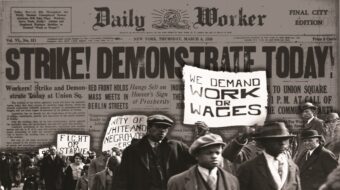
DALLAS – Activists joined the national effort for “First Friday Vigils” on behalf the unemployed on May 6, the day that the Bureau of Labor Statistics released new unemployment data. The Dallas office of BLS is downtown, in the A. Maceo Smith Federal Building, Griffin & Young. They leafleted Department of Labor employees, including those from BLS, and others as they took their lunch break. The headline news that day had been “Economy Keeps Adding Jobs!” but the figures on the activists’ leaflets put the truth in perspective.
The text of the leaflets is as follows:
And still, nothing is being done!
From BLS 5/6/11
- The official number of unemployed persons: 13.7 million, officially 9 percent of the workforce of 152 million
- Official African American unemployment: 16.1 percent
- Official Hispanic unemployment: 11.8 percent
- Official teenage unemployment: 24.9 percent
- Marginally attached workers (unemployed but not looking): 2.5 million
- Long term unemployed for more than 27 weeks: 5.8 million
- Involuntary Part-time workers: 8.6 million
- Sum of direct victims of unemployment crisis: 13.7+2.5+8.6=24.8 million or 16 percent (of course, we’re all victims because wages and benefits are depressed)
- The average workweek for all employees on private nonfarm payrolls: 34.3 hours
- Productivity rose another 1.6 percent in the first quarter, 2011
- GDP grew by an annualized rate of 1.8 percent in the first quarter of 2011, a decline from the previous quarter’s 3.1 percent rate.
- Initial claims for jobless benefits spiked sharplyin early May to 474,000. The trend is toward more unemployment.
And still, nothing is being done. In fact, the Texas Legislature may well deliberately cause 330,000 more layoffs.
Six people handed out the leaflets. Most of them came from the main federal building, three blocks away, where the Dallas Peace Center had sponsored a prayer vigil. To the people who stopped to listen, they explained that a mass movement is necessary if any resolution of the jobs crisis is possible. They explained the relationship between rising productivity, outsourcing of jobs, increasing part-time and temporary work, depression of everybody’s wages and benefits and slow economic growth to the jobs crisis.
Everyone in attendance agreed with the analysis.

MOST POPULAR TODAY

‘Warning! This product supports genocide’: Michigan group aims to educate consumers

Hold the communism, please: SFMOMA’s Diego Rivera exhibit downplays artist’s radical politics

Ohio: Franklin County treasurer attends Netanyahu meeting, steps up Israel Bond purchases

“Trail of Tears Walk” commemorates Native Americans’ forced removal

After months of denial, U.S. admits to running Ukraine biolabs






Comments